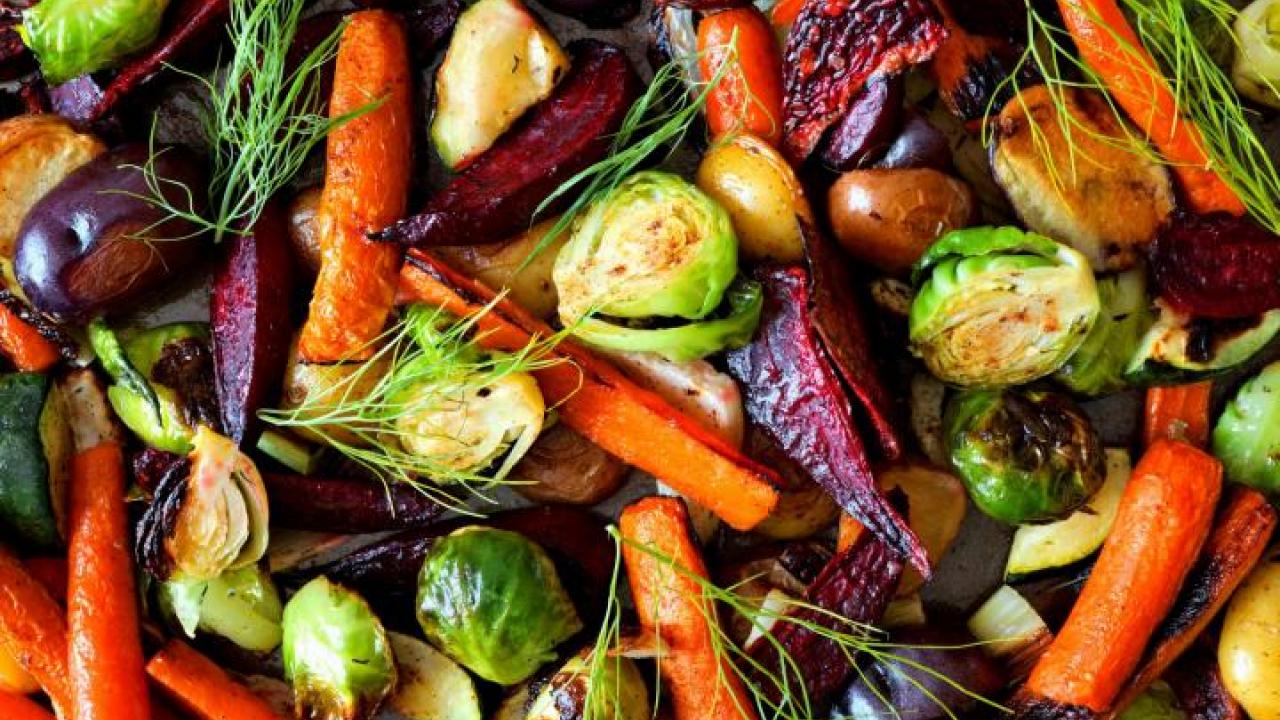
November - Eat in Color!
We often forget to appreciate the colors we see in the produce section. Red, yellow, orange, green, blue, purple—you are actually witnessing the magical work of pigments. Pigments are naturally occurring chemical compounds that give color to the fruits, vegetables, and fungi that we enjoy at the dinner table every day, and they not only help make our food look visually appealing, but they have been cyan-tifically shown to provide some superpower health benefits.
Consuming more colorful produce can increase anti-inflammatory activity, reduce oxidative stress, support immune function, and even help fight diabetes and cardiovascular disease. And let’s not forget to consider the additional dietary fiber, vitamins, and minerals the fruits and veggies offer beyond the pigments they contain!
Get to Know the Four Families of Plant Pigments
- Carotenoids – responsible for red, orange, and yellow colors in foods, like carrots, corn, squash, tomatoes, sweet potatoes, peaches, tangerines, and mangos
- Chlorophylls – responsible for the green in foods, like spinach, broccoli, kale, asparagus, green beans, green cabbage, and collard greens
- Flavonoids (ie. Anthocyanins & Anthoxanthins) – responsible for yellow, red, blue, & purple colors in foods like red cabbage, red onion, eggplant, blueberries, cranberries, and grapes.
- Betalains – responsible for yellow & red-violet colors in foods like beets, swiss chard, and dragon fruit.
To fully take advantage of these pigments’ health benefits, it is important to consider how you cook your food.
The color of these natural pigments is sensitive to the addition of heat and changes in pH during the cooking process. Furthermore, their bioavailability, or its readiness to be absorbed by the body, can also vary based on the method that it is cooked, but you can use this knowledge to make sure that your dishes come off the pan still jam-packed with goodness and more vibrant than ever!
Cooking with Color in Mind
- Carotenoids are more bioavailable after cooking and is better absorbed when lipids are present, so it is best to prepare carotenoid-rich foods by roasting or sautéing in a little oil. If you are using another cooking method that does not require any fat, like blanching, make sure to include some other source of healthy fats in your meal to assist in carotenoid absorption!
- Chlorophyll pigments can be better retained through shorter cooking times at higher temperatures. If you’re blanching greens and want to keep the vegetables’ vibrant green color, it is also better to blanch with a higher volume of water and add the greens in when the water is already boiling.
- Flavonoids like Anthocyanins are more unstable at high heat and pH and can be leached out when boiled. Baking is the best cooking method to increase the bioavailability of these pigments.
With the holiday season fast approaching, plan to add some more plant-based color to your family feasts (or your daily meal rotation). It’s easy and it doesn’t mean that you have to sacrifice delicious!
Tips for Adding More Colorful Fruits and Vegetables to Your Plate:
- Up the Veggie Ratios – When you’re preparing dishes that include a part of vegetables, add a quarter to a third more than what the recipe calls for. If your recipe doesn’t include any vegetables, try to incorporate some as a side or mix some in, if you’re feeling brave and experimental.
- Upgrade Vegetables to Main Dish Status – They’re too good to be just a side! Normalize serving vegetable-based main dishes. Check out some recipes below!
- Don’t Underestimate Fruit – Easily include fruits into many dishes in the form of zest, fresh squeezed juice, or even garnish. In some recipes, you can even use fruit (like apples, pears, or peaches) as a natural source of sweetness. If not, serve fruit as a dessert.
- Go Fresh – Because pigments are sensitive to heat and pH changes, fresh have more than canned due to heat processing. Although cooking with fresh ingredients may give you more control over the color, flavor, and nutrients of your dishes, canned versions are convenient, easy to store and do have nutritional value.
- Experiment with Plant-Based Substitutions – If you have a favorite a sauce or recipe that you usually serve or cook with animal-based protein, try it with tofu, tempeh, eggplant, mushrooms, cauliflower, or any other vegetable you might like. You’ll get both the flavor you enjoy and the nutrients your body will love.
Let’s show some love and gratitude for nature’s best this season!